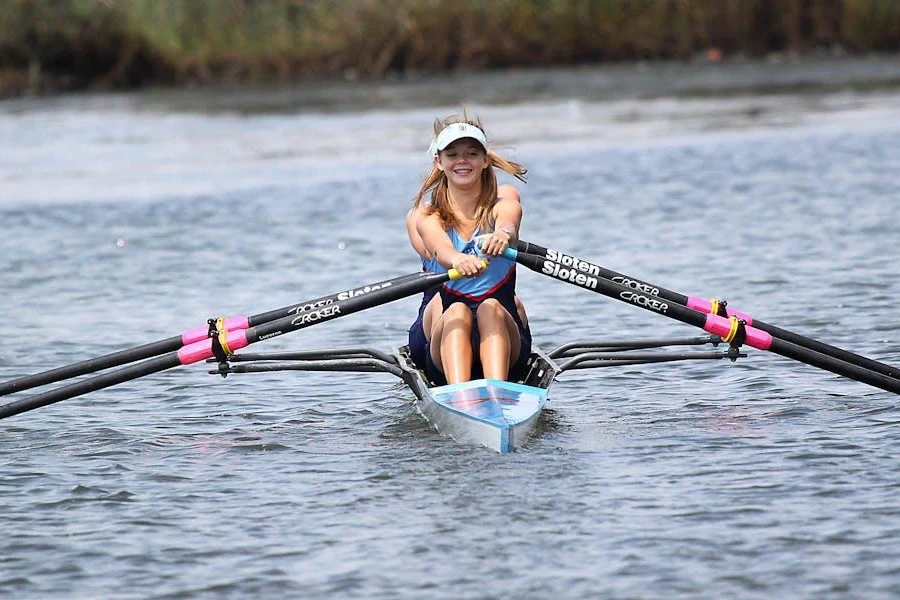Rowing is highly engaging! This water sport perfectly blends teamwork and athleticism to offer an amazing competitive or recreational experience. Although rowing is incredibly easy for anyone to do, the boats themselves determine if consumers (beginners or advanced) will enjoy a rewarding and enjoyable rowing adventure.
Since various rowing boats exist, sellers must first understand their features, suitability, and performance capabilities before choosing the best ones to sell. This comprehensive guide will explore all must-know considerations before stocking up on rowing boats in 2024.
Table of Contents
The state of the rowing boat market in 2024
Types of rowing boats
Things to consider when purchasing rowing boats
Bottom line
The state of the rowing boat market in 2024
Experts say the global rowing boats market reached US$ 10.2 billion in 2023, with predictions showing it will keep growing at a 5.50% compound annual growth rate (CAGR) from 2024 to 2030. The market is experiencing significant growth due to rising interest in water sports/recreational activities, increasing disposable income, rising number of health-conscious consumers, the surging tourism and leisure industry, and growing disposable income.
Based on type, single-scull rowing boats generated the most demand in 2023. The racing segment also emerged as the dominant segment, registering recreational rowing as the second most popular application. Also, wooden rowing boats emerged as the most popular in the material segment, with metal following closely behind. And North America is leading the global market with an over 38% share of the total revenue.
Types of rowing boats
1. Sculling boats

Sculling boats have special designs for rowers who prefer using two oars in each hand to control their vehicles. They are super maneuverable, making them turn and move easily in the water. Below are the main types of sculling boats:
I. Single sculling boats
Single sculling boats, or singles, are rowing boats designed for one person. They are long and narrow, with a sliding seat for the rower to sit on and foot stretchers to keep their feet in place. Manufacturers typically make these boats from lightweight materials, like carbon fiber or fiberglass, to make them easier to handle and faster on water. These boats are popular for both recreational rowing and competitive racing. Overall, single-sculling boats provide a challenging yet rewarding experience for rowers of all levels.
II. Double sculling boats
As the name implies, double sculling boats make enough space for two rowers. Like single sculls, doubles are long and narrow but are wider than single sculls. They also have sliding seats for each rower, allowing them to move back and forth with their strokes.
Each rower has their own set of oars and oarlocks on opposite sides of the boat. Although many people use them for recreational rowing, the competitive side uses double-sculling boats to showcase teamwork and coordination.
III. Quad sculls
When people want a social and exciting rowing experience, they turn to quad-sculling boats. These boats are longer and wider than single and double sculls to accommodate multiple rowers. Like doubles, coordination, and synchronization for rowers is crucial for maintaining the boat’s speed and stability.
2. Sweep boats
For sweep rowing boats, each rower has only one oar, which contrasts sculling, where rowers have two oars each. With these boats, rowers alternate sides with their strokes, meaning they are either on the port (left) or starboard (right). Common sweep rowing boats include pairs, fours, and eights. It’s perfect for competitions.
Things to consider when purchasing rowing boats
Skill level

Sellers should not stock up on rowing boats without considering their target audience’s skill level. Different boats require different levels of experience and proficiency to handle effectively. Here are the other reasons why sellers shouldn’t overlook skill level:
Boat stability
Some rowing boats, like wider and more stable recreational boats, are better suited for beginners. Why? Because the wider and more stable a rowing boat is, the easier it will be to balance and maneuver. More advanced boats, such as racing sculls, are narrower and less stable, requiring greater skill to keep upright—so they will appeal to more advanced rowers.
Technique requirements
Certain rowing boats (like sculling boats with two oars per rower) demand more refined techniques and coordination compared to sweep rowing boats, where rowers use one oar each. Hence, beginners may find it easier to start their rowing journey with sweep rowing before progressing to the more advanced sculling.
Purpose

Choosing the right rowing boat also depends greatly on what consumers plan to do with it. Are they rowing for fun, to get fit, or to compete? Each boat is designed with a specific purpose in mind, so picking one that matches what consumers want to achieve is crucial
For example, if consumers row for fun or exercise, they might prefer a stable and comfortable recreational boat for easy handling. They won’t want to struggle with a difficult boat. But if they are training for competitions, sellers must offer them a sleek and fast shell. Those models are built for speed, so racing consumers can get all the training they need.
Water conditions

Knowing which water conditions will consumers be rowing in also helps determine the kind of boat construction they will be looking for. If they are mainly on calm lakes or rivers, rowers may prefer boats with less stability. Such water conditions generally don’t pose enough challenges to require something more sturdy.
However, if they plan to row in rougher waters or open seas, consumers will need something more stable and secure. Rowing boats designed for these conditions provide better stability and performance, ensuring consumers stay safe and comfortable despite the challenging environment.
Weight and portability
Consumers must move their boats around if they want to use them, making weight and portability very important when picking rowing boats. Lighter boats (120 to 160 pounds) are easier to handle and transport, making them more convenient if consumers move them frequently. So, if consumers plan on transporting their boats often, such as taking them to different waterways or storing them in smaller spaces, opting for lightweight and portable options can save them time and effort. On the other hand, heavier boats (180 to 220 pounds) have more stability but can be a pain to handle and transport.
Material
Rowing boats must have enough durability to withstand the rigors of potential impacts, water, and waves. And this durability is directly linked to the materials manufacturers use to construct them. Here is a better look at the different materials and their perks:
| Rowing boat material | Perks |
| Fiberglass | Fiberglass is incredibly popular for rowing boats because of its durability, strength, and relatively low cost. Fiberglass rowing boats offer excellent resistance to water and weather damage, making them suitable for recreational and competitive rowing. |
| Carbon fiber | Carbon fiber is the best material for high-performance rowing boats. It’s lightweight and extremely strong, providing excellent stiffness and responsiveness. That’s why competitive rowers prefer carbon fiber boats. However, they are more expensive than other materials. |
| Wood | Wooden rowing boats offer a classic and elegant appearance most people love. However, they go beyond aesthetics to provide the best durability and buoyancy for rowing boats. While they require more maintenance than fiberglass or carbon fiber boats, many consumers swear by wooden boats for their craftsmanship and traditional appeal. |
| Kevlar | This synthetic fiber is widespread because of its exceptional strength and resistance to impact and abrasion. Rowing boats made from Kevlar are lightweight yet highly durable, making them suitable for various rowing applications, including racing and touring. |
| Aluminum | Aluminum rowing boats are lightweight, durable, and corrosion-resistant, making them ideal for use in saltwater environments or for recreational rowing. They are also relatively affordable compared to boats made from other materials. |
Bottom line
Rowing may be a sport of teamwork and athleticism, but all that sportsmanship will be for nothing if consumers don’t have the right boat. Beginners can’t handle certain boat types, while the pros wouldn’t deliver maximum performance with other types. As a result, sellers should understand the key factors discussed in this article before dipping their toes in the rowing boat market.
Once they are ready, sellers can prepare themselves to handle their chunk of the 60,500 consumers searching for rowing boats this year. So whether you are new to the rowing market or looking to enhance your inventory, these tips will ensure you offer your buyers the right rowing boats, in turn increasing your revenue in 2024!



